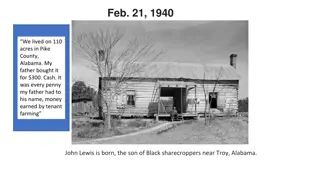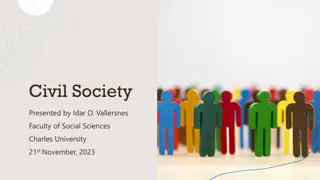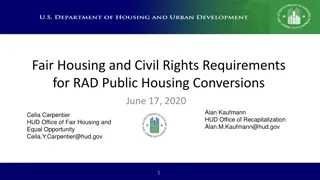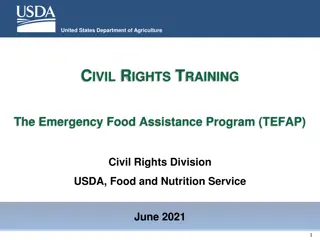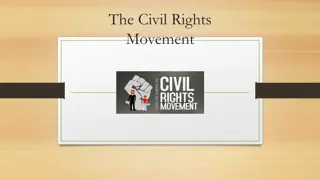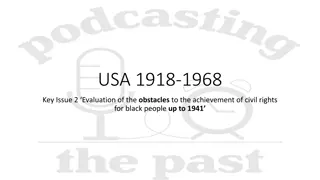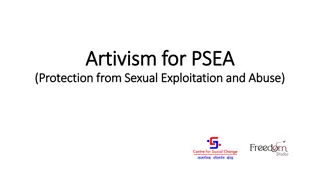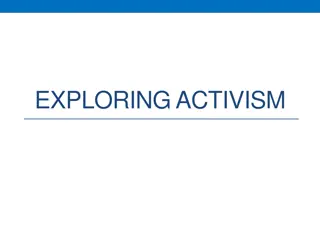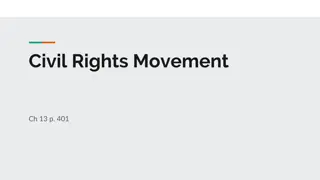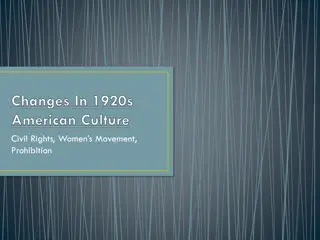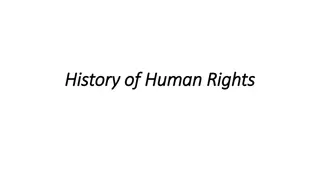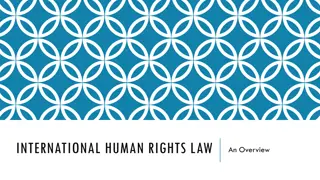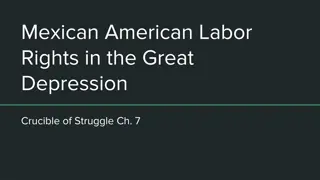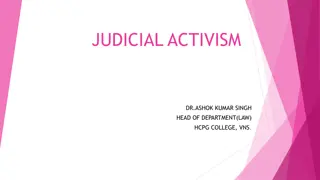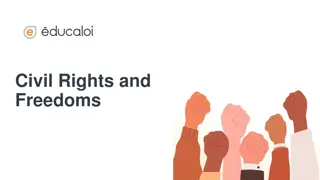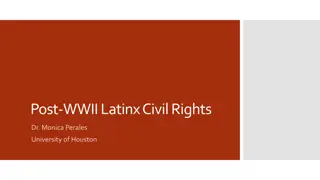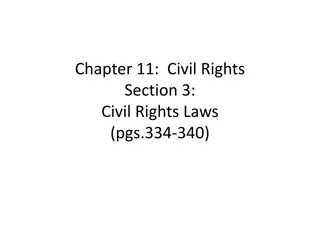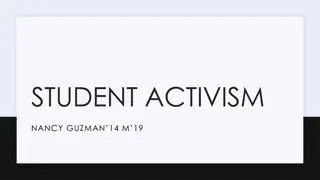Student Activism & Civil Rights Struggles in America
Student activists in the Civil Rights Movement challenged segregation with determination. Sit-ins, SNCC's nonviolent protests, Freedom Riders' bravery, and President Kennedy's intervention marked key moments in the fight for racial equality in America.
Download Presentation

Please find below an Image/Link to download the presentation.
The content on the website is provided AS IS for your information and personal use only. It may not be sold, licensed, or shared on other websites without obtaining consent from the author.If you encounter any issues during the download, it is possible that the publisher has removed the file from their server.
You are allowed to download the files provided on this website for personal or commercial use, subject to the condition that they are used lawfully. All files are the property of their respective owners.
The content on the website is provided AS IS for your information and personal use only. It may not be sold, licensed, or shared on other websites without obtaining consent from the author.
E N D
Presentation Transcript
27.2 The Movement Gains Ground
Student Activists Make a Difference Young African American began to challenge segregation with new vigor and determination.
Sit-ins Challenge Segregation White waitress refused to serve 4 African American students at restaurant. In South this was common. To protest the four students sat down on the stools at the lunch counter where they stayed until closing time. Sit ins spread rapidly
SNCC Promotes Nonviolent Protest Young activists establish a new civil rights organization Goal was to create a grass roots movement that involved classes of African Americans in the struggle to defeat white racism and to obtain equality.
Riding for Freedom Next battleground was interstate transportation. Boynton v. Virginia segregation on interstate buses and in waiting rooms was illegal.
Freedom Riders Face Angry Mobs CORE staged a freedom ride through the Deep South. Two separate buses from Washington D.C. bound for New Orleans. Enroute they defied segregationist codes. In Alabama the trip took a dangerous turn. After departing from Anniston, pro-segregationist s firebombed one of the buses. When the second bus arrived in Birmingham a white mob attacked the riders.
President Kennedy Takes Action Photographs of bombed out buses promoted JFK to take action to stem the violence against the freedom riders. Police and state troopers protected the freedom riders. Federal Transportation Commission issued an order to desegregate of interstate transportation. In exchange JFK said they would not intervene with authorities arrested activists and sentenced them to jail for disturbing the peace. Freedom writers achieved immediate goal.
Protests and Confrontations Intensify: Meredith Integrates the University of Mississippi In September 1962, Air Force veteran James Meredith tried to enroll at the all-white University of Mississippi The federal courts ordered the school to desegregate in 1962. Mississippi s governor resisted, creating a stand-off between the federal government and the state government. When Meredith arrived on campus, a riot ensued; two men were killed in the fighting.
Once again, President Kennedy intervened, assigning federal marshals to protect Meredith. Meredith graduated from the University of Mississippi in 1963. He later obtained a law degree from Columbia University. Tragically, civil rights activist Medgar Evers, who was instrumental in helping Meredith gain admittance to Ole Miss, was murdered in June 1963.
King Campaigns in Birmingham In the spring of 1963, civil rights leaders focused their efforts on the South s most segregated city Birmingham, Alabama. Initially, the protests were nonviolent, but they were still prohibited by the city. City officials used police dogs and fire hoses against the protestors. Rev. Martin Luther King, Jr., himself was arrested for violating the prohibition. Shocked Americans demanded that President Kennedy take action to end the violence.
Kennedy Backs Civil Rights Calling it a moral issue, Kennedy proposed sweeping civil rights legislation.
The Movement Marches on Washington Civil rights leaders held a March on Washington to pressure the government to pass the President s new Civil Rights bill. On August 28, 1963, hundreds of thousands of people from all around the country gathered in Washington, D.C., to demonstrate. As millions more watched on television, Rev. Martin Luther King, Jr., stood before the Lincoln Memorial and delivered his unforgettable I Have a Dream speech
Congress Passes the Civil Rights Movement In September 1963, less than three weeks after the march, a bomb exploded in the church that headquartered the SCLC in Birmingham. Four young African American girls were killed. On November 22, 1963, President Kennedy was assassinated. Vice President Lyndon B. Johnson assumed the presidency. Johnson continued to work for passage of Kennedy s civil rights legislation
The legislation passed in the House of Representatives, but faced even more opposition in the Senate. A group of Southern Senators blocked it for 80 days using a filibuster. (an action such as a prolonged speech that obstructs progress in a legislative assembly while not technically contravening the required procedures) Supporters put together enough votes to end the filibuster. The measure finally passed in the Senate.
In July, the Civil Rights Act of 1964 was signed into law. Banned segregation in public accommodations. Gave government the power to desegregate schools. Outlawed discrimination in employment. Established the Equal Employment Opportunity Commission.



